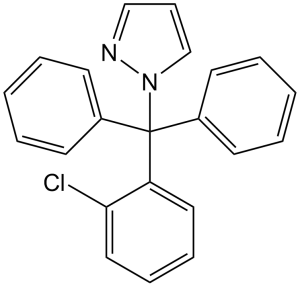
| 规格 | 价格 | 库存 | 数量 |
|---|---|---|---|
| 5mg |
|
||
| 10mg |
|
||
| 25mg |
|
||
| 50mg |
|
||
| 100mg |
|
||
| 500mg |
|
||
| 1g |
|
||
| Other Sizes |
| 靶点 |
Calcium-activated K+ channel (IKCa1) (Kd=20 nM)
|
||
|---|---|---|---|
| 体外研究 (In Vitro) |
TRAM-34 选择性阻断 IKCa1 电流 (Kd=25 nM),TRAM-34 还以相同的功效阻断人 T84 结肠上皮细胞中的 IKCa1 电流 (Kd= 22 nM)。 TRAM-34 可阻断人类 T 细胞中的克隆和天然 IKCa1 通道,Kd 为 20-25 nM,选择性比其他离子通道高 200 至 1500 倍。剂量响应曲线表明,移液器中 1 μM 钙的 Kd 为 20±3 nM,希尔系数为 1.2 [1]。 TRAM-34 是 KCa 3.1 通道的选择性抑制剂,可根据浓度促进或降低细胞增殖。在中等浓度 (3-10 μM) 下,TRAM-34 可增强细胞增殖,但在较高浓度 (20-100 μM) 下,TRAM-34 会降低细胞增殖。雌激素受体拮抗剂 ICI182,780 和他莫昔芬可阻止 TRAM-34 产生的细胞增殖增强。 TRAM-34 还增强孕激素受体 mRNA 表达,降低雌激素受体-α mRNA 表达,并减少放射性标记雌激素与 MCF-7 雌激素受体的结合,在每种情况下都模仿 17β-雌激素受体乙二醇的参与 [2]。
|
||
| 体内研究 (In Vivo) |
连续 7 天单次静脉注射 TRAM-34(0.5 mg/kg;29 μM)的小鼠 (n = 5) 没有表现出临床表现异常。 TRAM-34治疗组的体重数据(第1天:17.8克;第7天:27.0克)与注射媒介物的对照小鼠的体重数据(第1天:17.4克;第7天:23.4克)相匹配。总体而言,根据这些小毒性实验的结果,TRAM-34 的剂量是阻断通道所需量的 500-1,000 倍时,并不会造成严重危险 [1]。 TRAM-34 治疗后,病变区域的苏木精和伊红 (H&E) 测量值显着降低;平均梗塞面积从对照组(n=8)的22.6±3.6%下降到10 mg/kg TRAM-34。在用 40 mg/kg TRAM-34 治疗的大鼠中,该百分比从大鼠的 11.3±2.8% 降至 8.1±1.9% (n=8;P=0.004) (n=6,平均值±sem,P=0.039)。此外,这种治疗有助于减少大脑萎缩。但只有40 mg/kg TRAM-34组的结果有统计学意义(P=0.013),而10 mg/kg组的结果则没有统计学意义(P=0.11)[3]。
|
||
| 酶活实验 |
ER竞争性结合试验[2]
竞争性结合试验如下进行。MCF-7细胞蛋白(250µg)在室温下在TEDG缓冲液中在0.1 nM[2,4,6,7,16,17-3H(N)]-雌二醇([3H]-E2)(110 Ci·mmol−1)(总终体积为500µL)的存在下孵育2小时。在非放射性E2过量100倍的情况下评估非特异性结合TRAM-34和E2标准品在添加到细胞质蛋白之前,在不含酚红的5%DCC-FBS MEM补充剂中稀释。载体对照由5%DCC-FBS MEM组成,含有0.7%DMSO的补充剂。为了将ER结合的[3H]-E2与未结合的[3H]-E2分离,加入250µL羟基磷灰石(HAP,60%在TEDG缓冲液中),在15分钟内每5分钟涡旋一次混合物,并在1000×g下离心10分钟。用TEDG缓冲溶液洗涤HAP-[3H]-E2-ER复合物,离心并重复洗涤步骤。为了从HAP-[3H]-E2-ER复合物中洗脱[3H]-E2,加入500µL 100%乙醇,然后将混合物孵育15分钟,并在1034×g下离心10分钟。分离出的[3H]-E_2被移除并加入2 mL闪烁液中。使用Beckman LS 5000TA闪烁计数器对放射性进行定量。在四次独立的蛋白质提取中,对[3H]-E2与TRAM-34的竞争进行了四次测定。Scatchard分析确定表观解离常数为0.135±0.034 nM(n=3),最大结合容量为48.3±5.4 fmol·mg−1(=3)。 |
||
| 细胞实验 |
[3H]胸苷掺入试验。[1]
将静息或2天活化(10 nM PMA或5 ng/ml抗CD3 Ab)的PBMC以每孔2×105个细胞的速度接种在平底96孔板(最终体积200μl)的培养基中。用药物预孵育的细胞(60分钟)用丝裂原(10 nM PMA+175 nM离子霉素或5 ng/ml抗CD3抗体)刺激48小时。在最后6小时加入三联体胸苷([3H]TdR)(每孔1μCi)。将细胞收集到玻璃纤维过滤器上,并在闪烁计数器中测量放射性。 细胞活力的流式细胞术测量。[1] 细胞以5×105个细胞/ml(Jurkat E6-1,MEL细胞,人T淋巴细胞)或105个细胞/ml(C2F3成肌细胞,CHO,COS-7,L929,NGP和NLF神经母细胞瘤,RBL-2H3)接种在12孔板中。药物(5μM)以0.1%的DMSO终浓度加入,发现不会影响细胞存活率。48小时后,通过抽吸(悬浮细胞)或胰蛋白酶消化(贴壁细胞系)收集细胞,离心,重新悬浮在含有1μg/ml碘化丙啶(PI)的0.5ml PBS中,并在FACScan流式细胞仪上测量红色荧光。死细胞的百分比是通过其PI摄取来确定的,每个样本中有104个细胞被分析。 |
||
| 动物实验 |
|
||
| 参考文献 |
|
||
| 其他信息 |
TRAM-34 is an organochlorine compound.
|
| 分子式 |
C22H17CLN2
|
|
|---|---|---|
| 分子量 |
344.84
|
|
| 精确质量 |
344.108
|
|
| 元素分析 |
C, 76.63; H, 4.97; Cl, 10.28; N, 8.12
|
|
| CAS号 |
289905-88-0
|
|
| 相关CAS号 |
|
|
| PubChem CID |
656734
|
|
| 外观&性状 |
White to off-white solid powder
|
|
| 密度 |
1.1±0.1 g/cm3
|
|
| 沸点 |
510.2±50.0 °C at 760 mmHg
|
|
| 熔点 |
145-147ºC
|
|
| 闪点 |
262.4±30.1 °C
|
|
| 蒸汽压 |
0.0±1.3 mmHg at 25°C
|
|
| 折射率 |
1.617
|
|
| LogP |
5.65
|
|
| tPSA |
17.82
|
|
| 氢键供体(HBD)数目 |
0
|
|
| 氢键受体(HBA)数目 |
1
|
|
| 可旋转键数目(RBC) |
4
|
|
| 重原子数目 |
25
|
|
| 分子复杂度/Complexity |
396
|
|
| 定义原子立体中心数目 |
0
|
|
| InChi Key |
KBFUQFVFYYBHBT-UHFFFAOYSA-N
|
|
| InChi Code |
InChI=1S/C22H17ClN2/c23-21-15-8-7-14-20(21)22(25-17-9-16-24-25,18-10-3-1-4-11-18)19-12-5-2-6-13-19/h1-17H
|
|
| 化学名 |
1-[(2-chlorophenyl)-diphenylmethyl]pyrazole
|
|
| 别名 |
|
|
| HS Tariff Code |
2934.99.9001
|
|
| 存储方式 |
Powder -20°C 3 years 4°C 2 years In solvent -80°C 6 months -20°C 1 month |
|
| 运输条件 |
Room temperature (This product is stable at ambient temperature for a few days during ordinary shipping and time spent in Customs)
|
| 溶解度 (体外实验) |
|
|||
|---|---|---|---|---|
| 溶解度 (体内实验) |
配方 1 中的溶解度: ≥ 2.08 mg/mL (6.03 mM) (饱和度未知) in 10% DMSO + 40% PEG300 + 5% Tween80 + 45% Saline (这些助溶剂从左到右依次添加,逐一添加), 澄清溶液。
例如,若需制备1 mL的工作液,可将100 μL 20.8 mg/mL澄清DMSO储备液加入400 μL PEG300中,混匀;然后向上述溶液中加入50 μL Tween-80,混匀;加入450 μL生理盐水定容至1 mL。 *生理盐水的制备:将 0.9 g 氯化钠溶解在 100 mL ddH₂O中,得到澄清溶液。 配方 2 中的溶解度: 2.08 mg/mL (6.03 mM) in 10% DMSO + 90% (20% SBE-β-CD in Saline) (这些助溶剂从左到右依次添加,逐一添加), 悬浊液; 超声助溶。 例如,若需制备1 mL的工作液,可将 100 μL 20.8 mg/mL澄清DMSO储备液加入900 μL 20% SBE-β-CD生理盐水溶液中,混匀。 *20% SBE-β-CD 生理盐水溶液的制备(4°C,1 周):将 2 g SBE-β-CD 溶解于 10 mL 生理盐水中,得到澄清溶液。 View More
配方 3 中的溶解度: ≥ 2.08 mg/mL (6.03 mM) (饱和度未知) in 10% DMSO + 90% Corn Oil (这些助溶剂从左到右依次添加,逐一添加), 澄清溶液。 配方 4 中的溶解度: 30% PEG400+0.5% Tween80+5% Propylene glycol : 30mg/mL 配方 5 中的溶解度: 5 mg/mL (14.50 mM) in 20% SBE-β-CD in Saline (这些助溶剂从左到右依次添加,逐一添加), 悬浊液; 超声助溶。 *20% SBE-β-CD 生理盐水溶液的制备(4°C,1 周):将 2 g SBE-β-CD 溶解于 10 mL 生理盐水中,得到澄清溶液。 1、请先配制澄清的储备液(如:用DMSO配置50 或 100 mg/mL母液(储备液)); 2、取适量母液,按从左到右的顺序依次添加助溶剂,澄清后再加入下一助溶剂。以 下列配方为例说明 (注意此配方只用于说明,并不一定代表此产品 的实际溶解配方): 10% DMSO → 40% PEG300 → 5% Tween-80 → 45% ddH2O (或 saline); 假设最终工作液的体积为 1 mL, 浓度为5 mg/mL: 取 100 μL 50 mg/mL 的澄清 DMSO 储备液加到 400 μL PEG300 中,混合均匀/澄清;向上述体系中加入50 μL Tween-80,混合均匀/澄清;然后继续加入450 μL ddH2O (或 saline)定容至 1 mL; 3、溶剂前显示的百分比是指该溶剂在最终溶液/工作液中的体积所占比例; 4、 如产品在配制过程中出现沉淀/析出,可通过加热(≤50℃)或超声的方式助溶; 5、为保证最佳实验结果,工作液请现配现用! 6、如不确定怎么将母液配置成体内动物实验的工作液,请查看说明书或联系我们; 7、 以上所有助溶剂都可在 Invivochem.cn网站购买。 |
| 制备储备液 | 1 mg | 5 mg | 10 mg | |
| 1 mM | 2.8999 mL | 14.4995 mL | 28.9990 mL | |
| 5 mM | 0.5800 mL | 2.8999 mL | 5.7998 mL | |
| 10 mM | 0.2900 mL | 1.4499 mL | 2.8999 mL |
1、根据实验需要选择合适的溶剂配制储备液 (母液):对于大多数产品,InvivoChem推荐用DMSO配置母液 (比如:5、10、20mM或者10、20、50 mg/mL浓度),个别水溶性高的产品可直接溶于水。产品在DMSO 、水或其他溶剂中的具体溶解度详见上”溶解度 (体外)”部分;
2、如果您找不到您想要的溶解度信息,或者很难将产品溶解在溶液中,请联系我们;
3、建议使用下列计算器进行相关计算(摩尔浓度计算器、稀释计算器、分子量计算器、重组计算器等);
4、母液配好之后,将其分装到常规用量,并储存在-20°C或-80°C,尽量减少反复冻融循环。
计算结果:
工作液浓度: mg/mL;
DMSO母液配制方法: mg 药物溶于 μL DMSO溶液(母液浓度 mg/mL)。如该浓度超过该批次药物DMSO溶解度,请首先与我们联系。
体内配方配制方法:取 μL DMSO母液,加入 μL PEG300,混匀澄清后加入μL Tween 80,混匀澄清后加入 μL ddH2O,混匀澄清。
(1) 请确保溶液澄清之后,再加入下一种溶剂 (助溶剂) 。可利用涡旋、超声或水浴加热等方法助溶;
(2) 一定要按顺序加入溶剂 (助溶剂) 。
|
|---|